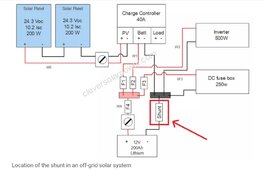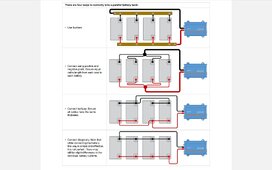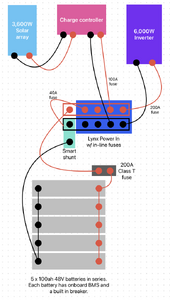I've recently built an off grid home in Belize. The solar system was installed as part of a package and I had no control over the specific components, wiring etc. I'm now trying to understand the system top to bottom and begin making improvements to it starting with the installation of a smart shunt. I've created this diagram for the purposes of discussing the improvements to the system. My first problem is that the way I've wired the smart shunt between the negative battery terminal and the inverter, it is blind to the charge controller input coming into the opposite end of the battery bank and therefore only reports the power being used and not the charge coming in. The system currently has no fuses or busbars so my plan is to add a positive and negative busbar and update the connections for the inverter and charge controller to both connect at the bus bar, vs opposite ends of the battery bank, but wanted to confirm that wouldn't cause other problems before proceeding.
Related, I had trouble restarting the battery bank after having everything shut down to make this change which exposed a problem with either the wiring or components of this system. The installer said the restart sequence was "complicated" and came to do it themselves vs explaining it to me over the phone. When they arrived I understood why quickly as it involved reconnecting the last battery to the bank with a small wire from a cell phone charger slowly to avoid the current causing the BMS systems of each battery to start alerting which is what was happening to me when turning them back on as wired. After the last/top battery started with the connection with the smaller wire, they slowly connected the inverter/battery connection with the 2/0 wiring and everything remained running without issue. The question here is really just if the busbar changes will fix this as well or if there are additional safety changes I should make with a fuse on the positive connection and/or a disconnect switch as well.
Related, I had trouble restarting the battery bank after having everything shut down to make this change which exposed a problem with either the wiring or components of this system. The installer said the restart sequence was "complicated" and came to do it themselves vs explaining it to me over the phone. When they arrived I understood why quickly as it involved reconnecting the last battery to the bank with a small wire from a cell phone charger slowly to avoid the current causing the BMS systems of each battery to start alerting which is what was happening to me when turning them back on as wired. After the last/top battery started with the connection with the smaller wire, they slowly connected the inverter/battery connection with the 2/0 wiring and everything remained running without issue. The question here is really just if the busbar changes will fix this as well or if there are additional safety changes I should make with a fuse on the positive connection and/or a disconnect switch as well.







